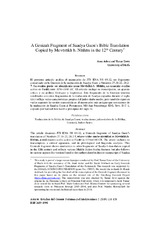A Genizah Fragment of Saadya Gaon’s Bible Translation Copied by Mevōrākh b. Nāthān in the 12th Century
Autor
Ashur, Amir
Zewi, Tamar
Editor
UCOPressFecha
2019Materia
Traducción de la Biblia de Saadya GaonTraducciones judeo-árabes de la Biblia
Guenizá
Judeo-Árabe
Saadya Gaon’s Bible Translation
Judeo-Arabic Bible Translations
Genizah
Judeo-Arabic
METS:
Mostrar el registro METSPREMIS:
Mostrar el registro PREMISMetadatos
Mostrar el registro completo del ítemResumen
The article discusses JTS ENA NS 69.12, a Genizah fragment of Saadya Gaon’s translation of Numbers 27.18-22, 28.2-7, whose scribe can be identified as Mevōrākh b. Nāthān, a well-known scribe active in Fusṭāṭ in 1150–1180 CE. The article includes its transcription, a critical apparatus, and its philological and linguistic analysis. This Genizah fragment shows similarities to other fragments of Saadya’s translation copied in the 12th century and reflects various Middle Judeo-Arabic features but also follows in various aspects the version found in the earliest dated inclusive manuscript of Saadya Gaon’s translation of the Pentateuch known to us, MS St. Petersburg RNL Yevr. II C 1, copied by Samuel ben Jacob in the beginning of the 11 th century. El presente artículo analiza el manuscrito de JTS ENA NS 69.12, un fragmento conservado en la Guenizá de la traducción de Saadya Gaon a Números 27.18-22, 28.27. Su escriba puede ser identificado como Mevōrākh b. Nāthān, un conocido escriba activo en Fusṭāṭ entre 1150–1180 d.C. El artículo incluye su transcripción, un aparato crítico y su análisis filológico y lingüístico. Este fragmento de la Guenizá muestra similitudes con otros fragmentos de la traducción de Saadya copiados durante el siglo XII y refleja varias características propias del judeo-árabe medio, pero también sigue en varios aspectos la versión transmitida en el manuscrito más antiguo que conocemos de la traducción de Saadya Gaon al Pentateuco, MS San Petersburgo RNL Yevr. II C 1, copiado por Samuel ben Jacob a principios del siglo XI.

